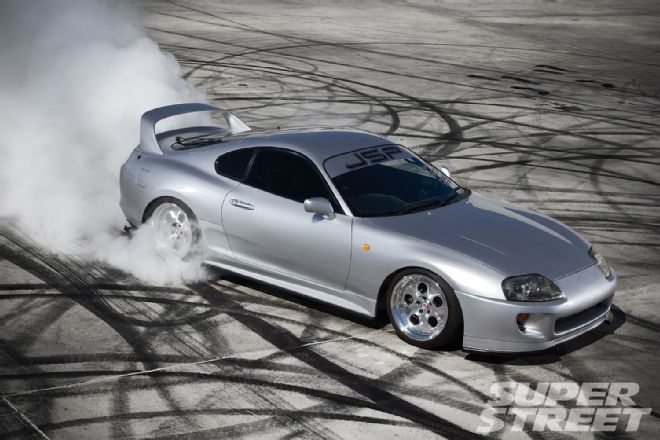It sounds easy enough, even though Google tells us in more than 25-million ways how to get it done, almost all of which involve stepping about the clutch, stabbing the gas pedal and modulating both until either your front or rear tires billow up amidst gray clouds of unadulterated machismo. One-time Formula D driver John Russakoff’s methodology is a bit more specific and a bit more learned, but the fundamentals aren’t very different.
Having a 500hp Supra will do that to you. Lay in to the throttle with a Supra like Russakoff’s then try to convince yourself that anything more is anything but lavishly unnecessary and exponentially more expensive, although sub-1000-hp 2JZ-GTEs might not exactly impress the strength gluttons. Exactly 490whp through a single-turbo-converted inline-six comes relatively simply. The fuel injectors: stock. 91 octane: all day long. The boost: a conservative 16psi. The modifications made to the 2JZ remain simple but important. Within the walls of his San Diego, California-based fabrication facility, JSP, the factory sequential turbo duo was chucked in favor of an individual Precision 6165 that mounts to the Supra’s head through a custom JSP stainless steel exhaust manifold. It’s a tried and proven combination-one which, according to Russakoff, could easily yield upward of another 100hp with at most a measly swap in the injectors combined with a quick retune of the Haltech engine management system.All of these would make those burnouts even easier to come by. Even in stock form, though, Supras were designed for tire roasting. Its RWD layout allows whoever’s lighting things up out to simultaneously sidestep the brake pedal, retaining the burnout formation indefinitely, which is typically proportional to how smart he isn’t, or simply how much disposable income he’s got for things like tires, transmissions and clutches. More power makes everything easier, and pedaling the brakes while doing all of this inside your 110hp FWD bucket of frugalness will never sound right. All of this is partly why Russakoff drives a Supra and not a Saturn Vue-a Japanese-only RZ model at that. Japanese-market Supras like the RZ were sold with a power disadvantage in comparison to North American versions-280hp in comparison with 320hp-but the bones are mostly exactly the same, and once the slightly-limited JDM-only turbos are out of the picture, all is right. That may be, if you’re into right-hand drives and all of.
1993 toyota supra RZ race port blow off valve and fuelall of that smoldering rubber is a one-off set of HRE 454s looking at the Vintage Series line-the only set ever made especially for the Supra and is every bit as expensive as you’d imagine. The remainder of this fourth-generation Toyota is surprisingly simple. TEIN coilovers make up the extent of its chassis modifications along with the MKIV’s brakes remain consistent with whatever Toyota’s engineers wanted twenty years ago. Beneath the hood and along the body are where Russakoff’s touches lay. Custom JSP front spoiler extensions made from fiberglass give new meaning for the Supra’s beak along with Shine Auto Project sideskirts along with a Top Secret-style rear diffuser that help redefine and lower the car’s lines.
A shortage of online burnout tutorials there isn’t, and one doesn’t need 490hp to take part. No matter what you drive, the opposing physical laws of intended velocity and frictional forces don’t care, nor do whatever form of rubber and cords separate your jalopy from the pavement. Google it. Seek guidance from friends. If you have to, ask your parents. Just get it done. The ability of the burnout is one that won’t soon go out of style.
